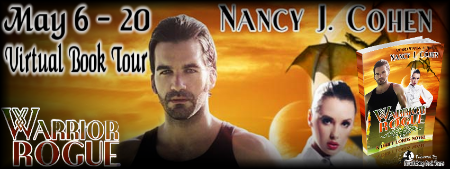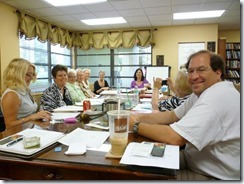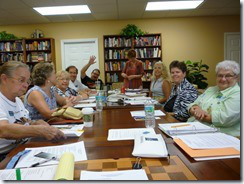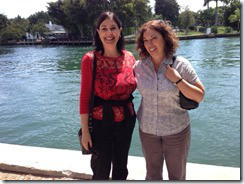Nancy J. Cohen's Blog: Nancy's Notes from Florida, page 93
April 26, 2013
Warrior Rogue Release Day
Warrior Rogue, #2 in the Drift Lords series, is now available in print and multiple digital formats!
Excerpt
The engine whine surged as the jet lifted. She gripped the counter to steady herself.
He didn’t budge, his cobalt eyes narrowing. “The prophecy says we must be together. It may not be what either of us wants, but there is no denying Fate.” 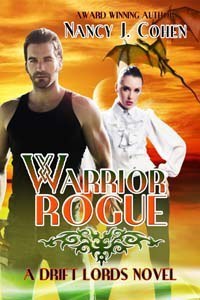
Oh, but I do want you, buddy. And judging from the bulge in your pants, the feeling is mutual. “What prophecy?”
His mouth quirked up at the edges. “The one that claims you and I have to join forces to fight evil.”
Here he goes with his delusional nonsense again.
She jabbed her finger in the air. “The only reason we’re together is because I offered you a job. We should discuss your duties. They do not include seducing me.”
He lifted an eyebrow. “If that’s true, why did you kiss me back and put your arms around me?”
His knowing smile made her stutter. “T-That was a momentary lapse. It won’t happen again.”
“Won’t it? You felt it, too, the connection between us. I knew it the moment I saw your watch. Your destiny is written there, and it’s linked to mine.”
<><><>
<><><>
Follow My Blog Tour and Win Prizes April 30-May 20
CLICK HERE to Enter my Release Day Contest April 26-May 19! You can win a hand-made troll figurine by Trolls of Norway or a runner up prize of a signed copy Wicked Women Whodunit.

No purchase is necessary. You must be at least 18 years old to enter. By submitting your entry, you agree to be entered into the author’s email newsletter list. Your information will not be shared with anyone else, and you may unsubscribe at any time. Winner will be notified by email. Author is not responsible for transmission failures, computer glitches or lost, late, damaged or returned email. Winner agrees for their name to be used in conjunction with the contest on the author’s social media sites.
<><><>
Join the Launch Day celebration on my Facebook Page (and Like the page while you’re there)– today only!
Leave a comment and be entered into my grand prize blog tour drawing for a $25 Amazon or BN gift card.
Have you ever met anyone you consider could be a troll?


April 22, 2013
Chicken and Bean Stew
Chicken and Bean Stew
2 pounds chicken thighs or 5-6 chicken breasts, boneless and skinless
1/3 cup all-purpose flour
3 Tbsp. oil
1 medium onion, cut into chunks
3 peeled carrots, cut into chunks
1 tsp. chopped garlic
14.5 oz. can diced tomatoes
1 can low sodium chicken broth
1 can cannelloni beans, drained and rinsed
¼ cup dry red wine (or more if needed to moisturize)
Preheat oven to 350 degrees. Sprinkle flour in a plate and dredge chicken pieces to coat.
Heat 2 Tbsp. oil in a Dutch oven and brown chicken on all sides. Remove from pot. Deglaze with a bit of broth if necessary and add 1 Tbsp. oil. Stir in onion and carrots and sauté until onions wilt. Add garlic and stir. Add diced tomatoes. Place chicken on top. Pour broth and red wine over chicken. Bring to a boil, cover, and cook in oven for 30 minutes. Add beans. Cook for approximately 30 minutes more or until chicken is done. Serves 4-6.
<><><>
This recipe came out very tasty and has lasted us a few nights. Now if you want another new recipe, be sure to sign up for my quarterly newsletter. The next one goes out April 26 and has a bonus giveaway just for subscribers, in addition to book news and contest announcements. Visit my Website and look for the sign-up form in the left sidebar.
Tomorrow, look for my new release to be spotlighted at The Revolving Book.


April 17, 2013
Goodreads Giveaway
Enter to win a signed print copy of Warrior Rogue (The Drift Lords Series #2). Contest runs April 17 – May 2.
“There is never a dull moment in this action-packed sci-fi fantasy. With a liberal dose of steamy romance thrown in, this tale is sure to keep you engrossed to the very end…With well-developed characters and a quick-moving plot, you will have no trouble abandoning your own life for a while as you experience life in the fast track with Jen and Paz. You’re in for a wild ride.”
Goodreads Book Giveaway

Warrior Rogue
by Nancy J. Cohen
Giveaway ends May 02, 2013.
See the giveaway details
at Goodreads.


April 16, 2013
Creating Vibrant Characters
This past weekend, guest speaker Joanna Campbell Slan told us how to create vibrant characters. First she mentioned four personality styles. Dialogue should reflect if the person is a tell versus an ask kind of guy. This sounds like me and my husband. He is ALWAYS asking questions. He’ll say, “Why is that man cutting his grass so early?” I’ll say, “I wonder why he’s cutting his grass so early.” See the difference?
Which comes first, character or plot? Start by developing your characters. Give them conflicts, differing viewpoints and reactions. Problems between them will create tension. Remember that if any strength is overused, it becomes a weakness. An example is the character who will get the job done, but at any cost. Or it can be the person who follows rules no matter what happens.
Give each person a habit and a telling detail that helps identify him. Also, pair a physical description with an emotional one for each character.
Have your characters work toward a goal. The four personality types will react differently. One group may ask numerous questions and want to know the rules. Another group may spend time getting organized and elect someone to take notes. Group three might just play around and have fun. And group four will be the ones who take charge and accomplish the task.
Joanna offered a lot more tips in this valuable workshop. This only touches the tip of the iceberg on what she covered. But keeping just these few bits of advice in mind is helpful.


April 11, 2013
Time Management for Writers
How do you balance writing with online promotion? Marketing efforts take hours on the Internet. How can you keep up with tweets, Facebook posts, Pinterest, and more?
I am always asked this question whenever I give talks. It’s not easy to strike a balance. Often the online business takes over. But here are my Four Rules to guide you.
(1) Writing Comes First.

Set yourself a daily writing or revision quota. When I am writing, I must complete 5 pages a day or 25 pages per week. When I’m doing self-edits, I try for a chapter a day but that doesn’t always work out. Either way, I must move forward with my current project.
Finish at least half of your quota before allowing yourself to check email. Or if you must, do a quick email check first to get it off your mind.
Limit your time online or you’ll get sucked into cyberspace. Go offline after the allotted time and return to your writing. Finish your daily quota. Then you can have the rest of the day free for social networking, meeting friends, or whatever suits your fancy.
(2) If things get too hectic, take Time Out.
Planning a blog tour, tweeting about a new release, guest blogging on another website, and running a contest? Does this make you nuts? Does it make your breathing come short and your pulse race? Time to calm down. Do something fun for thirty minutes. Take a walk, polish your nails, read a cooking magazine, play with your pet, listen to music. When you feel calmer, go back to work.
(3) Set aside time just for marketing.
If things are building to an intolerable level, you may need to take a few days off to focus solely on promotion. Prioritize your projects. What needs to get done first? Tackle one thing at a time. Do you have to get your next email newsletter ready to go? Do it. Need to plan a Rafflecopter contest? Fill out the form. Have two weeks of blogs to write for an upcoming virtual tour? Decide upon your topics and write drafts for each one. Accomplishing a few of the items on your promotional campaign list will help you feel more in control.
(4) Realize that life interferes. It’s going to happen, so take the time you need to deal with strife, and don’t feel guilty about being away from the computer. It happens to everyone. You’ll get your mojo back when the time comes. If not, you’ll find something else to bring your life meaning. We follow different paths throughout life. Yours may take you in another direction.
Today is an example of how I work these rules. I did a few pages of revision this morning for about an hour. Then I allowed myself to scan my email. I answered the few items that needed a personal reply, and then shut off my Outlook program. I took a walk. Did more pages. Went on the exercise bike. Line edited some more. Peeked at email again. Back to the chapter. Finally, I finished my page quota for the day. It’s only 12:30 pm, but I started at 4:30 am. And now I’m writing this blog. Oops, the lawn guy is here and I need to talk to him. Big distraction. Go out, have discussion, back to work on blog. And so on through the afternoon. I could work, or I could go out with friends or my husband and take time off without any guilt. Because the writing comes first. When that’s done, all the rest is gravy.
Remember to visit our site over at Booklover’s Bench where I’ve joined with several other writers to offer contests, excerpts, and more.
Also, please sign up for my quarterly email newsletter. I’ve an issue coming out April 26 and there’s a bonus subscriber drawing for some free books by my fellow BB authors. Look in the left sidebar on my Website for the sign-up form.
How do you balance your writing time with promotion?


April 4, 2013
Keeping Characters Apart
By Beate Boeker
Nancy asked me to share some writing tips with you, and I thought I would focus on one aspect that every writer encounters – how to keep people apart. In a mystery, you start with a few key people: The heroine or hero, the murderer, victim one, maybe victim two.
In my cozy mystery series, Temptation in Florence, I have both—a heroine called Carlina, and Inspector Stefano Garini who’s the hero. 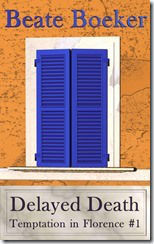
As I’m switching viewpoints between both of them, I think it’s fairly easy to get those people clear in your mind. At the beginning, I characterize them in turn by judging them through the eyes of the other. Here’s the moment when Carlina meets Garini for the first time:
Carlina dropped onto the sofa and looked at the Commissario who took a seat in the battered armchair to her left. His face was lean and thin, and his nose reminded her of a hawk. No, the resemblance with a hawk came from the eyes. They were light and hard and gave her the impression he could spot a detail at a distance of several kilometers. He didn’t look like someone who would understand a silly mistake or two.
Garini in turn discusses her with his assistant Piedro. I’ve made Piedro a bit slow, so much so that he only has to say one sentence, and you pretty much realize that this is the dumb assistant even if you have forgotten his name in the meantime.
“What was her name? Carlina?” Piedro asked.
“No. Caroline Ashley.”
Piedro frowned. “Everybody called her Carlina.”
“A nickname.” For an instant, Stefano saw Carlina’s pale face again. The freckles had made her look younger than she was. Her eyes reminded him of a cat, slanted and intelligent.
Piedro shrugged off the name. “She acted real nervous.”
“Yes, I noticed that too.”
So far, so good. You’re unlikely to forget the victim and the hero(s). However, as an author, you need to populate the scene with plenty of other people milling about in order to create enough red herrings.
Carlina is part of a huge family, and many of the members live in the same house which is split up into individual apartments. On the ground floor, to the right, we have her grandfather Nico, who was murdered. On the left is the apartment of her grandfather’s identical twin. His name is Teodoro Alfredo Mantoni. He’s the most senior man in the house, the patriarch of the family, so I made sure that everybody calls him Uncle Teo, instead of just Teo, and whenever he enters the scene, I mention something that immediately refers to his age – his rheumy eyes, the age spots on his skin, his white hair.
Each of the twins has seven kids, all adults with their own families now. I created this huge family on purpose, to have enough room for further novels. However, I do not introduce all of them in the first novel, to avoiding confusing my readers (and myself!).
Uncle Teo is married to Aunt Maria, who is not only exceedingly fat, but who likes to eat garlic in huge quantities. As soon as she makes an entry, everybody runs to the window or speaks through the nose.
On the next floor, we have on one side Benedetta, who is one of Nico’s younger daughters. Her two teenage kids (seventeen and nineteen) live with her. Her husband died some years ago.
At this point, I feared the eyes of the reader would already glaze over, so I gave each of the appearing persons one special trait. Whenever they appear, I repeat this trait to help my readers stay oriented. Benedetta is always using bright red lipstick. She’s calm and pretty normal in this exuberant family. Her kids both have bright red hair. The younger is Ernesto, the elder Annalisa. Annalisa is very much focused on herself, besides being a true beauty. Ernesto loves to play computer games. I assumed that if I mentioned the red hair throughout the novel as a sort of signal, my readers would immediately be able to place both Ernesto and Annalisa.
Across the landing is their elder sister Emma’s apartment. She’s getting married to Lucio in the first novel. Emma knows exactly what she wants, and she has fantastic legs. Lucio is extremely jealous and traditional, so I made sure to refer to this whenever they appear.
Another floor up, we have Fabbiola. She is Carlina’s mother, and her strand of henna-colored hair is the most typical thing about her. She also has a little habit of carrying around a cushion whenever she leaves the house, so she’s clearly a bit batty, but in a nice sort of way. Whenever Fabbiola appears, the cushion appears, too, and I think this is too eccentric to be forgotten easily.
Carlina is fiercely loyal to her family, and this loyalty is her biggest problem, not only when it comes to finding the murderer but also in her relationship with Garini, who has no large family at all and is the quintessential lonely wolf.
Besides these typical traits I keep mentioning throughout the novel, I gave the characters very different names, some long, some short, and I made sure I did not have them start with the same letter. (I slipped up on Ernesto and Emma, but it’s too late to change that now!). There’s nothing more confusing than a whole family that’s called Lea, Lou, and Liz.
I don’t have any animals in my novels so far, but if they appear, I will give them animal names, like Woof for a dog or Purr for a cat. This might not be very creative, but I once read a novel where the dog was called Sarah, and it threw me time and again. “Sarah followed him into the house.” All through the chapter, I kept wondering ‘Who was Sarah again?’ – until she finally started to bark.
In addition to the traits I keep repeating, I’ll remind the reader of each character’s relationship to Carlina as soon as possible in the course of a natural conversation. Here’s an example:
“Where’s father?” Carlina’s mother sidled along the pew closer to her daughter. Her long blue skirt twisted around her legs, and she pulled it free with an impatient tug.
“Ssshhh.” Carlina placed a finger on her lips and pointed at the altar where Emma and Lucio stood in front of the priest.
Fabbiola stood on tiptoe and brought her mouth to her daughter’s ear. “Why were you so late?”
In this short paragraph, I have mentioned the words mother, daughter, and Fabbiola’s name, so even the most casual reader should be able to place Fabbiola now.
If someone doesn’t make an entry very often, I often use a blunt question from a comparative outsider to help get everybody oriented. Here’s an example from book number two, Charmer’s Death:
Benedetta continued. “We met her in town because she was still at Giulietta’s.”
“Who is Giulietta?” Garini frowned.
“Giulietta is a cousin once removed,” Caroline replied. “She’s also a hairdresser.”
Sometimes, when writing, it feels as if you’re overdoing it. After all, this is your world, and you know these characters intimately. But your readers may be distracted. They may have been interrupted when reading the book the last time, and you don’t want them to be confused as to who’s talking and what on earth the character is doing there.
I hope this little explanation helps a little and would love to hear your thoughts!
<><><>
Delayed Death (Temptation in Florence) by Beate Boeker
What do you do when you find your grandfather dead half an hour before your cousin’s wedding? You hide him in his bed and tell everyone he didn’t feel like coming.
Delayed Death is an entertaining mystery set in Florence, Italy. When Carlina finds her grandfather dead on the day of her cousin’s wedding, she decides to hide the corpse until after the ceremony. However, her grandfather was poisoned, and she becomes the attractive Inspector’s prime suspect. On top of that, she has to manage her boisterous family and her luxurious lingerie store called Temptation, a juggling act that creates many hilarious situations.
BUY HERE: http://amzn.to/VMeCUz
<><><> 
Beate Boeker is a traditionally published author since 2008. She now offers many full-length novels and short stories online. Several of her titles were shortlisted for the Golden Quill Contest, the National Readers’ Choice Award, and the ‘Best Indie Books of 2012′ contest.
Beate is a marketing manager by day with a degree in International Business Administration, and her daily experience in marketing continuously provides her with a wide range of fodder for her novels, be it hilarious or cynical. While ‘Boeker’ means ‘books’ in a German dialect, her first name Beate can be translated as ‘Happy’ . . . and with a name that reads ‘Happy Books’, what else could she do but write novels with a happy end?
Website – www.happybooks.de
Facebook – Beate Boeker Author
https://www.facebook.com/pages/Beate-Boeker/153573758044433?ref=ts&fref=ts
Twitter - @BeateBoeker


April 2, 2013
What If? Plotting Made Perfect
The words “What If?” are at the heart of every plot. Currently I’m in the throes of plotting my next Bad Hair Day mystery. Having already written the draft of a synopsis, I welcome the “what if’s” that are flying into my brain.
What if the rivalry between ranchers Hugh and Raymond has a personal basis involving Hugh’s dead wife? What if the murdered forest ranger’s spouse had gotten turned down for a loan to start a business? Would that have induced her to take out a life insurance policy on her husband? What if the bad guy is selling his valuable ore to terrorists who resell it in exchange for weapons? What if….?
Once the story elements are in your head, your subconscious goes to work and new ideas keep popping up. Some are viable. Others get discarded as unrealistic. It’s wonderful when you get to this stage because the connections start snapping together. Pieces of the puzzle coalesce into a whole, and your story is ready for writing. But how do you reach this pinnacle of inspiration?
You begin with a story premise. In a mystery, it might be the victim. Who’d want to kill him and why? You sketch the suspects in your mind. Friends, family, and business associates who might have something to gain go on your list. What if suspect A’s wife was having an affair with the victim? And what if the husband discovered their liaison? What if suspect C owed the victim money? Or maybe the victim was extorting money from a colleague, knowing something that would get the guy fired. You examine their motives, seeking the secrets these people would do anything to hide.
Keep in mind that plot is not story. Plot is the background, the secrets everyone is keeping, the motive for the murder, the devious scheme created by the villain. You are creating a tapestry that leads to the opening scene. That’s where the story starts and moves forward.
In a romance, you’ll want to determine the first meet between hero and heroine. They’re attracted to each other but initially sparks fly between them. What if…they had a history together? Or what if she hates him because…? What if they have to work together in order to…?
Or a thriller: What’s at stake? Who is behind the dastardly scheme for world domination this time? Who’s the hero? What resources does he possess? How is he going to hit the ground running? What if…he’s semi-retired and he first gets wind something is wrong when…? He’s recalled to duty? He meets his old girlfriend and she says….? Or what if she’s in trouble? What if he receives a cryptic note from her?
Whenever I get ideas relevant to the plot, I jot them down in a plotting file for that book title. I may use them or not, but this way I don’t lose them.
Being a plotter and not a pantser, I write a complete synopsis before I begin writing the story. This synopsis may go through numerous drafts before I get it right. I pass it through my critique partners and make more changes. I ask my husband to read it so he can evaluate the logic. He’s good at catching things that don’t make sense or need clarification. In the case of my current WIP, I’m consulting my cousin who lives in the area where the story is set. She’s been invaluable in pointing out what works and what doesn’t.
I’ve been doing research on the Internet as I go along. I have a whole page of links and topics to explore. It comes to mind that I’ve been calling the law enforcement officer in the story a sheriff. Is this appropriate to the location? What’s the difference between a sheriff and a police chief? Does a sheriff only work for the county? Does this apply to a state other than Florida? Another item to research goes on my list.
Meanwhile, what other motives might people have for doing in the victim? What hidden connections might exist between my characters? Often these secrets reveal themselves during the actual writing process. New angles spring to life, taking the story in a new direction. But before you get there, you have to lay the foundation.
These story details possess you and take over your mind. You think about them all your waking moments. The plotting threads sizzle, curl, and snap in your brain like writhing snakes until one bites you. What if…?
<><><>
Are you a plotter or a pantser? Do you figure out these details as you write or before you begin the story?


March 31, 2013
Playing Tourist in Florida
Happy Easter to my friends who celebrate the holiday! As with any celebration, it’s a day to relax and enjoy your family and friends. In our busy lives, it’s not so easy to take a day off. I like to take walks and enjoy visiting parks when the weather is suitable.
We were lucky to be in Naples, FL during perfect weather to tour the Naples Botanical Garden. We’ve seen many of the other attractions in the area, but this was a first time here. After paying the $12.95 admission fee at the ticket booth inside the gift shop, we emerged onto the garden path. Different ecological areas are nestled among the 170 acres. Created in 1993 by a group of inspired Naples residents, the garden boasts seven habitats, 2.5 miles of walking trails, and restored native preserves. New construction is planned for a welcome center, auditorium, café, and more.
A sculpture exhibit was going on the same time as our visit. Enjoy the photos and picture yourself in sunny South Florida.
And here are my friends from Southwest Florida Romance Writers who gave me an excuse to go to Naples in the first place. I spoke to the group on “Social Networking for Writers.” You’ll see me at the far end in the first photo.
<><><>
As for other day off activities, we’ll often take a walk inside Sawgrass Mills Mall. Last week we went there to see Oz: The Great and Powerful. We liked this Disney movie despite the negative reviews. The storyline was clever and the scenery beautiful and creative. It reminded me of Avatar. We didn’t see it in 3-D but I would buy the DVD that way.
We discovered a new sushi bar inside the mall at a central location. Patrons sitting at the bar can watch sample dishes glide by on a conveyor belt.
Another day, I met my friend Margaret, a former member of Florida Romance Writers. We dined with our husbands at La Bonne Crepe on Las Olas Boulevard in Fort Lauderdale. I indulged in the baked brie with fruit and an iced tea.
After lunch, we strolled by the New River to see the Water Taxi landing where a bunch of people waited for the boat. That’s one adventure I haven’t done yet.
Where do you go on your days off?


March 26, 2013
Shine On Blog Award
Thanks so much to David Fernandez for nominating my blog for the Shine On Award. David discusses writing, sports, movies, and more at his entertaining site, so stop by for a visit. Thank you, David, for the nomination. It’s always nice to know people are reading my posts!
The Shine On Award
The Shine On Award Rules
Link back to and thank the blogger who nominated you.
Post the badge on your blog.
Answer the questions posed to you.
Nominate five bloggers who shine a little light in your day and notify them.
Ask five questions for your nominees.
David’s Questions for Me
(1) Are you a Plotter or a Pantser?
I develop my characters first, and then I’ll plot the story. I write a complete synopsis before I begin writing. This acts as my guideline, but that’s not to say the story doesn’t change as I write it. When I finish the book, I’ll go back and revise the synopsis accordingly. So I am definitely a plotter. I need to know where the story is going from the start.
(2) When you’re in a rut, where do you go for inspiration?
I’ll keep working out the plot in my head until something comes through. I might talk it out with my critique partners. Sometimes you just need a sounding board. Ideas may come to me when taking a walk or in the shower. The mind relaxes and allows a new connection to come through. It’s important to acknowledge these roadblocks as part of the writing process and to have faith that you’ll get through them like you do each time.
(3) What writer, living or deceased, would you compare your work to the most?
My work has been compared to Janet Evanovich for her humor. However, the humor in my mysteries is more wry and less slapstick. Also, my books are whodunits while hers are more adventures at heart. Jill Churchill’s humorous series is what first inspired my mysteries so my books could be compared to her Jane Jeffry stories with the funny titles. There are many other humorous cozy writers out there whose work has a similar tone. As for my romance series, Alyssa Day comes to mind for her Warriors of Poseidon series.
(4) What is your story writing process?
For a mystery, I decide on the victim and then determine the suspects. I’ll do character development sheets at that point to help me figure out each character’s possible motive. Preliminary research is done at this stage too. When I have these elements in my head, I write a synopsis. This acts as my writing guideline although the story might change. For a romance, I develop the main characters and then the plot. After the synopsis is finished, I put myself on a writing schedule of five pages a day. Once the book is done, I do several read-throughs for line editing, consistency, repetitions, and smoothness.
(5) What is your blog writing process?
When I get an idea, I’ll either jot it down or write the entire blog at that time. When I’m working on a book, I may note possible blog topics to use later on when I’m doing a blog tour. I don’t have set dates when I blog except on The Kill Zone, where I am a regular contributor every other Wednesday. I encourage reader feedback on my blogs.
And I nominate
Mudpies and Magnolias for the writing life by Maggie Toussaint: http://mudpiesandmagnolias.blogspot.com/
Terry’s Place for tips and strategies on writing by Terry Odell: http://terryodell.blogspot.com/
Scams & Cons for updates on scams by Terry Ambrose: http://terryambrose.com/category/scams/
Hasty Tasty Meals for easy-to-make recipes by Cheryl Norman: http://chefcheri.wordpress.com/
It’s Not All Gravy for life’s absurdities by Maryann Miller: http://its-not-all-gravy.blogspot.com/
My questions for the nominees are
What genre do you read for fun?
Do you revise as you go along or wait until your first draft is done?
What advice would you give aspiring authors?
Do you have beta readers and who are they?
What’s an interesting item you’ve researched for your current work in progress?


March 21, 2013
Discovering Your Story
Plotting your story can’t take place until you have an idea of issues you want to explore, setting, and character. Before you take pen to paper, you engage in the stage of Discovery. What does this mean?
Normally when planning a mystery, I start with the victim. Once the dead guy makes himself known, I create the suspects around him. Who had reason to want this person dead? What do they stand to gain? Who are the vic’s friends, business associates, and relatives? What secrets are they hiding? What issues are involved? Then I begin to explore possible motives. My research branches out, sometimes in new and interesting directions. Different elements swirl in my head, seep into my subconscious, and brew together until the plot pops out. Usually at this point, I can sit and write the entire synopsis.
But in researching my next mystery, I find myself going in a new direction totally. My characters will be transplanted from their normal Florida suburb to a ranch vacation in Arizona. I’m pondering a story that’s more an adventure than a whodunit, and the more fascinating items I research, the more excited I am getting. Copper mines, water resources, cattle ranches, ghost towns, haunted hotels, train rides…oh, my. A research trip is definitely required.
So far my notes are confined to Internet research but the various issues are becoming clarified. I am beginning to see what is possible and what may be implausible. These determinations will help when I debate my characters’ secrets and motives. I’m driven to discover more, to uncover additional tidbits that might influence my developing story. And I’m wondering if my readers will like reading more of an adventure or if I should stick to a traditional whodunit.
Or maybe this is all a pipe dream and these elements belong elsewhere, not with my series. But I’m excited for my happy couple to meet new challenges in a different location. Every few books in a series, when the setting gets to be same old, same old, you need to transplant your protagonists somewhere new for variety.
Sufficient time must be allotted for this discovery process. Plotting, research, and exploration are part of the pre-writing mode. Never feel guilty that you are not actually writing. You have to get it right, and only by digging into all the possibilities can you offer new material for the reader.
I am uncertain where I will go with this information I’m collecting. Maybe I’ll throw it all out and plot a traditional murder mystery. Or maybe I’ll go with the flow and drop my characters into a morass involving disputes over water resources, mining rights, ghost towns, and more. What do you think?


Nancy's Notes from Florida
- Nancy J. Cohen's profile
- 667 followers


